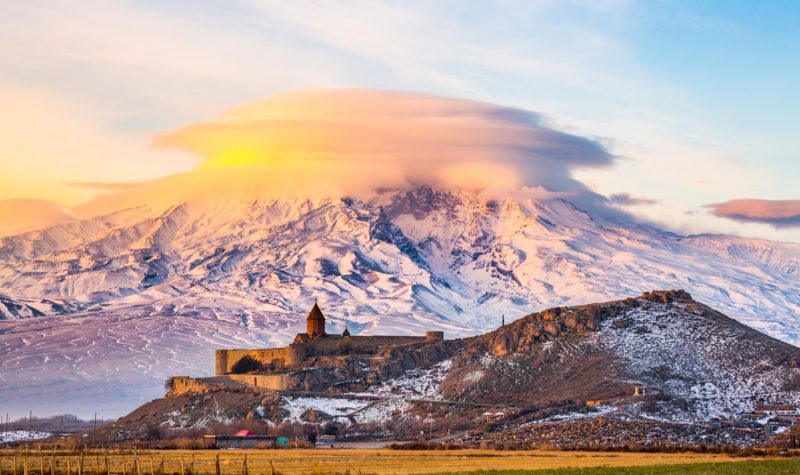Postcard from Yerevan: Observations from Armenia

The mountain glowers down upon the city. A brooding presence, you cannot escape it: Mount Ararat. It’s the place where Noah’s Ark came to rest when the Great Flood subsided. Or so I was taught in primary school. But this mountain, although the symbol of Armenia, is located in another country, on the other side of the River Aras – in Turkey.
That’s the Armenian issue in a nutshell. A Christian Kingdom which stretched from the Mediterranean to the Caspian Sea, when Britannia was still a cold, peripheral province of the Roman Empire, is now reduced to a diminutive lozenge of territory squeezed between Turkey, Georgia, Azerbaijan and Iran. Proverbially, it’s about the size of Wales. Armenia is friendly with two of those neighbours and distinctly hostile to the other two. Fortunately, their former masters, the Russians, are on-side.
The modern Republic of Armenia has a population of about three million people (and falling) but there are, as Armenians will tell you, about nine million fellow countrymen in the global Armenian diaspora[i], of which a half a million in France and at least the same number in the United States (maybe more). Apparently there is a suburb of LA which is a scene-steal for down-town Yerevan, complete with grandmas wearing headscarves selling shashlik. There is a flagrant parallel with Israel’s experience here – especially as overseas Armenians are renowned as successful business people, wherever they go. And I am told that overseas remittances are still a big contributor to the economy, here.
British Airways (LON:IAG) doesn’t fly here anymore. I am not sure if that says more about British Airways’ lack of gumption or Armenia’s poor prospects. I always ask drivers on the way from the airport – How is the economy? (Drivers who work for multinational banks pick up a lot of intelligence). Zero, my Armenian driver replied. Which is probably a bit harsh; though you couldn’t say the economy here is thriving, as I would love to tell you.
But the business hotels of Yerevan – all the usual suspects, indistinguishable chains – are decent – and busy. I have met some incredibly keen-minded bankers who are doing amazing things in challenging conditions. You see, the economic weather is not ideal. The main problem for Armenia right now is that big brother Russia, far-and-away Armenia’s biggest trading partner, is in trouble. I had not realised quite how badly.
I changed planes in Moscow on the way down where I picked up a copy of the English-language Moscow Times. If things are bad in “Europe” (I increasingly wonder what that word means), they are worse in Russia. The economy is going pear-shaped slowly. Ethnic gang-fights are front-page news. Last week a mass brawl involving about 500 people erupted at the Khovanskoye cemetery on the southwestern outskirts of Moscow, leaving at least three dead. Apparently, the Chechen gangs thought the Tajik boys were getting an unfairly large slice of the grave-digging business. Meanwhile, President Putin is tightening the thumbscrews on another news group – this time RBC Media.
The news that the oil price breached the psychologically significant US$50 mark this week will have been welcomed in Moscow. But it won’t make much difference. Russia needs an oil price of at least US$80 per barrel to balance its books. The government will still have to continue belt-tightening through protectionist measures which stymie imports of goods that are not easily substitutable by local providers. Imports are now down to 50% of their 2014 level. And investment is being cut to the bone and the incomes of state employees are shrinking. (Russian state employees, unlike French ones, do not strike however.)
Oil and gas revenues totalled Roubles 7.43 trillion in 2014 but dropped to Roubles 5.86 trillion in 2015. One forecast puts 2016 oil and gas revenues at Roubles 4.5 trillion. Policy makers can do nothing but wait for the commodity markets to turn. In the meantime, because under Mr Putin’s tenure of power there has been no substantive structural reform of the economy, Russia is trapped.
But back to Armenia. The French have been notable investors here, no doubt partly as a result of the Armenian diaspora in France. One of the leading commercial banks is owned by Credit Agricole (FRA:XSA). Pernod-Ricard (FRA:PER) bought the Ararat brandy distillery some years ago and has invested in this notable brand – much favoured, by the way, by Winston Churchill. New vines grown in the Amavir region are used to make the ubiquitous Karas wines, though I am told these are not widely exported.
Armenia’s potential as a tourist destination is huge. It has picture postcard lakes and forests, churches and castles. Currently, the largest number of tourists is either emigre Armenians or Iranians. The latter seem to appreciate the fact that, unlike in the Islamic Republic, one can get a drink here.
And how ironic that after the fifteen year spat about Iran’s nuclear technology, the Armenians, who operate one of the largest nuclear power stations in Asia (Russian – or rather Soviet – technology) now swap their nuclear-generated electricity for Iranian gas. No energy worries here.
The Armenians believe that Noah was Armenian. But then they also believe that Jesus visited Armenia. When you have been around such a long time, I think you are entitled to a few foibles. The Armenians are amongst the great survivors of history – and they are likely to be around a lot longer. I salute them.
[i] Wikipedia puts it at between 6.6 and 10.5 million – nobody knows the exact number.
Comments (0)